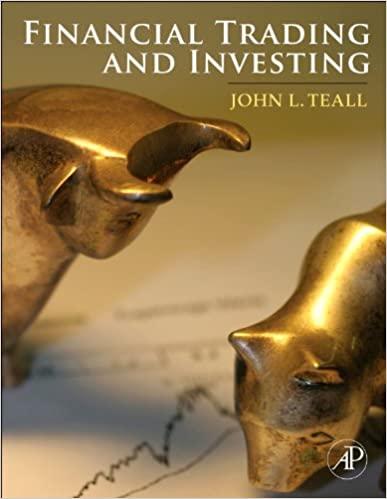Question
1) You have a portfolio of two assets, A and B. A has a standard deviation of 17% and B has a standard deviation of
1) You have a portfolio of two assets, A and B. A has a standard deviation of 17% and B has a standard deviation of 7%. You are unsure of the respective weights of the assets and their covariance in the portfolio. However, you know that the standard deviation of the portfolio is 6.5%. Which of the following is true?
- The covariance must be less than zero
- The weights cannot be 50% A and 50% B
- The weight of B cannot be 99%
2a) You are given the following information. Calculate the portfolios expected return, variance, and standard deviation.
| Investment | E(R) | Std Dev | Weight | Correlation Coefficient |
| A | 0.11 | 0.11 | 0.30 | 0.5 |
| B | 0.17 | 0.17 | 0.70 |
|
Assume the following changes occur.
| Investment | E(R ) | Std Dev | Weight | Correlation Coefficient |
| A | 0.11 | 0.19 | 0.30 | -0.22 |
| B | 0.17 | 0.17 | 0.70 |
|
2b) Does the portfolio standard deviation increase or decrease? How would you explain this change in standard deviation to a client?
3a) Lets revisit the figures above. Assume that the RFR = 0%.
Calculate the Sharpe ratios for 2a) and 2b)
3b) Explain which of the two is the more efficient portfolio is and why.
4) Suppose you have the following situation:
Stock Beta Expected Return
Hawaiian Celebrity Partydome 0.90 9.2%
Evil Gnomes Bad Cookies 1.80 16.4%
You are unsure of the risk-free rate and the return on the market. However, you are certain that the risk free rate has increased 2% from the last time expected returns were calculated. For which stock would you expect a more negative impact on its expected return? Explain.
5a) Calculate alpha for each portfolio. Assume that gamma equals 1% and the risk-free rate equals 2%.
| Portfolio | Portfolio Return | Market Std Dev | Portfolio Std Dev | Portfolio Correlation w/ Market | Market Return |
| A | 18.2% | 10.0% | 12.0% | 0.720 | 12.0% |
| B | 14.5% | 10.0% | 14.0% | 0.300 | 12.0% |
| C | 11.5% | 10.0% | 7.0% | 0.600 | 12.0% |
| D | 4.2% | 10.0% | 8.0% | 0.030 | 12.0% |
5b). Now assume that gamma for each portfolio was 0%. How does this alter Beta and Alpha in part a)?
6a) Assume the following: RFR = 7%, Rm = 14%
| Stock | Beta | Estimated Return |
| a | 0.5 | 0.08 |
| b | 1 | 0.10 |
| c | 2.2 | 0.12 |
| d | -0.5 | 0.09 |
| e | 0 | 0.03 |
Calculate the required return for each stock. Would you conclude the stocks are overvalued, undervalued, or fairly valued?
6b) Assume the risk-free rate rises to 5%. How does this alter your conclusions on valuations?
7a) Assume the following: The M portfolio has an expected return of 12% and a standard deviation of 7%. The risk-free asset has an expected return of only 7% and you can borrow and lend at the risk-free rate. What are the expected returns and standard deviations for portfolios with the following weights:
Risk-Free Asset M Portfolio
- 25% 75%
- 50% 50%
- 75% 25%
- -25% 125%
- -50% 150%
7b) Now, assume that you are able to borrow at 3%. Recalculate the expected returns and standard deviations for the portfolios above. Do you notice anything peculiar?
8) You are the investment strategist for a fund that currently invests 50% in stocks and 50% in bonds. However, you believe that the addition of asteroids would improve the portfolio by lowering risk and increasing return. You advocate a 20% allocation to asteroids, taking 10% from each of the other asset classes. Below, the following expected data has been developed to assist you:
|
|
|
| Correlation Matrix | ||
| Asset Class | Return | Standard Deviation | Stocks | Bonds | Asteroids |
| Stocks | 0.16 | 0.21 | 1 |
| |
| Bonds | 0.12 | 0.12 | 0.03 | 1 |
|
| Asteroids | 0.16 | 0.18 | -0.40 | -0.8 | 1 |
Note: The correlation matrix provides the correlations between asset classes. For example, the correlation between stocks and bonds based on the data provided is 0.03.
- Explain the effect on portfolio risk that would result from the addition of asteroids to the portfolio. Include in your answer two reasons for any change you expect in portfolio risk. (Note: It is NOT necessary to compute expected risk for the portfolio.)
- Your understanding of portfolio and capital market theory causes you to conclude that the data above is incorrect. Justify your skepticism.
Step by Step Solution
There are 3 Steps involved in it
Step: 1

Get Instant Access to Expert-Tailored Solutions
See step-by-step solutions with expert insights and AI powered tools for academic success
Step: 2

Step: 3

Ace Your Homework with AI
Get the answers you need in no time with our AI-driven, step-by-step assistance
Get Started


